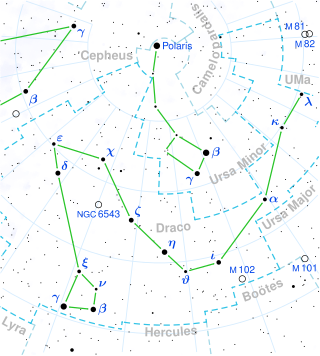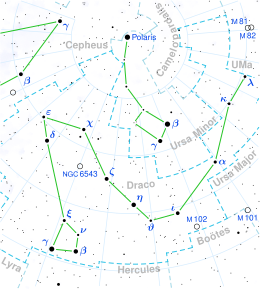Top Qs
Timeline
Chat
Perspective
Chi Draconis
Star in the constellation of Draco From Wikipedia, the free encyclopedia
Remove ads
Chi Draconis is a magnitude 3.6 binary star in the constellation Draco. At a distance of 27 light-years, it is one of the 200 or so closest stars.[9]
Remove ads
Nomenclature
Chi Draconis (Latinized from χ Draconis, abbreviated χ Dra, Chi Dra) is the star's Bayer designation. It also has the Flamsteed designation 44 Draconis.
In a 1971 NASA memorandum, this star was listed with the name Alahakan.[10] According to R. H. Allen's Star Names, Al ʽAuhaḳān, meaning "the two black bulls, or ravens", was an Arabic name for χ and ψ Draconis, among other stars in Draco.[11]
In Chinese astronomy, this star is identified as Yùnǚsì (御女四), the fourth star of the asterism Yùnǚ (御女, Maids-in-waiting; also 31 Leonis).[12] Alternatively, it may be Zhùshǐ (柱史, Official of Royal Archives),[13] usually identified as φ Draconis.[12] R. H. Allen (using a now outdated romanization of Chinese) said it was Kwei She.[11]
Remove ads
Binary system

χ Draconis is a spectroscopic binary which has been resolved using speckle interferometry.[4] The primary is an F7 main sequence star. The spectral type of the companion cannot be determined directly with any accuracy, but is known to be between G8 and K2 and is assumed to be K0. The properties of the secondary suggest that it is also a main-sequence star. The separation of the two stars varies between about 0.05″ and 0.2″ during the eccentric 182-day orbit.[14]
The primary star has a mass fractionally higher than the Sun's, but is significantly larger and hotter resulting in it being 86% more luminous.[3] Its age is estimated to be about five billion years.[2]
The secondary only has about three-quarters the mass of the Sun and is both cooler and smaller. It is only about 29% as luminous.[3] It is calculated to be 2.13 magnitudes fainter than the primary, so it would be of sixth magnitude if visible alone.[15]
Remove ads
Visual companions
Multiple star catalogues list faint widely-separated visible companion stars: a 12th-magnitude star and a 14th-magnitude star about 3′ from χ Draconis, but only about 10″ from each-other.[16] Both have much smaller parallaxes than χ Draconis and are unrelated background objects.[17]
See also
References
External links
Wikiwand - on
Seamless Wikipedia browsing. On steroids.
Remove ads

